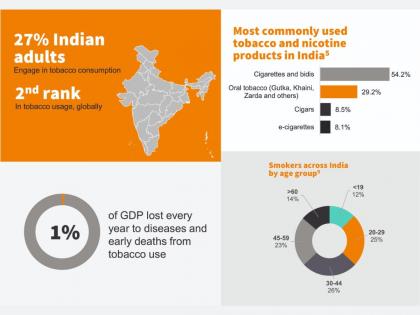1 Percent of GDP lost, 49 Percent of young adults consume tobacco: KPMG report highlights India’s Tobacco crisis
By PNN | Published: May 15, 2024 10:56 AM2024-05-15T10:56:53+5:302024-05-15T11:00:04+5:30
New Delhi (India), May 15: India's growth story has amazed economists and financial experts. Top rating agencies of the ...

1 Percent of GDP lost, 49 Percent of young adults consume tobacco: KPMG report highlights India’s Tobacco crisis
New Delhi (India), May 15: India's growth story has amazed economists and financial experts. Top rating agencies of the world have acknowledged that India will be the fastest growing economy among the G-20 nations in 2024. In the previous three quarters, India’s economy expanded at 7.8% in Q1, 7.6 per cent in Q2 and 8.4% in Q3.
However, the country's economy has a small dent that is resulting in a part of the financial growth going up in smoke – almost literally.
A report by KPMG Assurance and Consulting Services report titled Human-Centric Approach to Tobacco Control has revealed that India loses precious 1% of the GDP every year due to diseases and early deaths from tobacco use. India ranks second globally in tobacco and it is the highly productive age group that is succumbing to the temptation to use tobacco and tobacco-related products. In India, there is an alarming prevalence of tobacco smoking among the 20-44 age group (young adults). As per KPMG 2023 survey on tobacco consumption, about 49% respondents in this age group consume tobacco in both smoking and oral form.
Dr Narender Saini, Former General Secretary of the Indian Medical Association, said “Tobacco use affects both the health and economy. The burden of tobacco-related morbidity and mortality has been on the rise. Respiratory ailments, cardiovascular diseases and various forms of cancer dominate the landscape, claiming lives prematurely. The economic ramifications are equally profound. Families grappling with the consequences of tobacco-related diseases face financial hardship, often pushing many households into poverty. It is worrisome to see men in their prime age report with major lung impairment due to tobacco use. And it is sad that some of these bread-winners succumb to lung diseases.”
India also faces a dual challenge with both, smoking and oral tobacco use. With 250 million smokers between the ages of 16 and 64 as of 2018, India has the second highest number of tobacco users, says the report. This is because in India, legally produced cigarettes account for just 8% of the overall tobacco consumed, the remaining 92% of consumption is in the form of cheaper tobacco products such as bidis, chewing tobacco, khaini among others.
Says Dr Chhavi Gupta, DM – Infectious Disease, Senior Consultant at Yashoda Super-specialty Hospital, Kaushambi, Ghaziabad, an accomplished healthcare professional: “Efforts should be made to harness the power of technology that can amplify outreach efforts”.
Dr Gupta further adds, “There should also be an enhanced focus on making Nicotine Replacement Therapy (NRT) affordable and accessible.”
Another issue is that the trade of illicit cigarettes is gradually picking up in India. According to a 2022 study by FICCI Cascade, the illegal cigarette market in India is worth Rs 22,930 crore. The total loss incurred by the Indian government due to the illicit tobacco industry stood at Rs 13,331 crore in 2022, witnessing a 46 per cent increase from 2012.
As a solution, the report says a diverse array of alternative products and cessation techniques have proven to be effective in aiding individuals in their journey toward quitting tobacco.
The report says that the way forward in the battle against tobacco consumption entails a holistic and collaborative approach involving all stakeholders — producers, consumers, regulatory agencies, public health professionals and support groups.
The Ministry of Health and Family Welfare has included NRT products in the National Tobacco Control Program, emphasising the importance as a harm reduction tool.
There is a ray of hope. Over 15 states have enforced some form of ban on manufacturing and sale of oral tobacco products.
Says the KPMG report: It is imperative and critical for India to have a holistic roadmap towards tobacco harm reduction. There must also be proactive steps to promote collaboration between the government, public health experts, regulators, consumers, healthcare practitioners, among other stakeholders to develop innovative and effective harm reduction methods and alternatives.
If you have any objection to this press release content, kindly contact pr.error.rectification@gmail.com to notify us. We will respond and rectify the situation in the next 24 hours.
Disclaimer: This post has been auto-published from an agency feed without any modifications to the text and has not been reviewed by an editor
Open in app